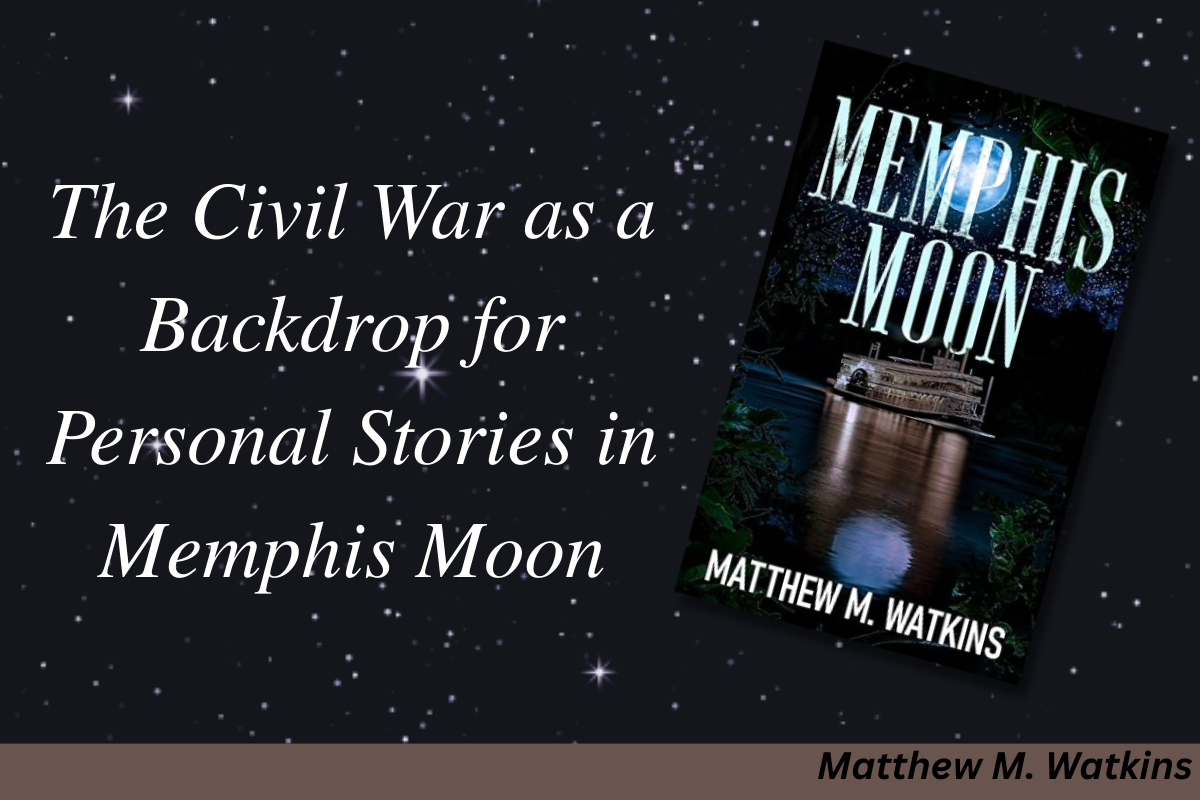When people think of the Civil War, the images that usually come to mind are cannons booming across bloodied fields, rows of soldiers in blue and gray uniforms, and speeches by Abraham Lincoln or Jefferson Davis. It’s easy to forget that behind the grand sweep of history were ordinary people—families, lovers, dreamers, and fighters—whose lives were forever altered.
Matthew M. Watkins’ Memphis Moon takes us into that forgotten world, blending factual history with fiction to remind us that the war was not just a clash of armies but a deeply personal ordeal. The novel follows Caleb Dawkins, Virginia “Ginnie” Moon, and the Moon sisters, capturing the way individuals lived and loved under the shadow of national conflict. By weaving together the personal and the political, Watkins shows how the human heart beats even in the darkest of times.
In this blog, we’ll explore how Memphis Moon uses the Civil War as a backdrop for intimate personal stories, why this approach makes the novel so compelling, and how it reflects broader truths about history and humanity.
Beyond Battles and Generals
History books often focus on dates, troop movements, and speeches. But the essence of historical fiction lies in turning those abstractions into lived experiences. Memphis Moon doesn’t just tell us that the Civil War divided Memphis—it shows us how a divided city forced its residents to make impossible choices.
For Caleb Dawkins, the war is more than a distant conflict. It shapes his sense of duty, morality, and identity. For Ginnie Moon and her sisters, the war transforms their lives in ways both heartbreaking and courageous. The Civil War may thunder in the background, but the real battles unfold in homes, taverns, and private hearts.
This is why the novel resonates: it reminds us that wars are not fought only on battlefields but in kitchens, parlors, and whispered conversations between lovers.
Memphis: A City at the Crossroads
The choice of Memphis as a primary setting is deliberate and powerful. During the Civil War, Memphis was both a strategic prize and a city wracked by division. Occupied by Union forces after 1862, it became a microcosm of the larger national conflict.
Watkins portrays Memphis not just as a backdrop but as a living, breathing character. The riverbanks hum with commerce and whispers of espionage. The taverns are filled with both camaraderie and suspicion. Families and friendships fracture under the strain of divided loyalties.
By grounding his story in Memphis, Watkins captures the emotional geography of the Civil War: a place where personal and political lines blurred and survival often depended on trust and secrecy.
Personal Stories Make History Human
Why do readers care more about Caleb and Ginnie than about the details of military campaigns? Because personal stories provide emotional entry points into history.
A statistic about 600,000 soldiers dead might leave us numb. But the sight of Ginnie struggling to protect her family, or Caleb wrestling with questions of loyalty and love, pulls us into the emotional reality of the war. Historical fiction thrives on this dynamic: it makes the distant past intimate.
When readers follow Caleb’s inner conflict or Ginnie’s resilience, they are not simply learning about the Civil War—they are feeling it. They imagine themselves in the same situation: Would I risk my life for love? Would I choose duty over desire? Could I survive such uncertainty?
These questions make history real.
Universality Across Time
One of the greatest strengths of Memphis Moon is its ability to show that, while the setting is the Civil War, the themes are timeless.
- Division: Just as Memphis was fractured between Union and Confederate sympathies, today’s societies face cultural and political divides.
- Love in Hardship: Caleb and Ginnie’s romance echoes the universal truth that love persists even in chaos.
- Resilience: The Moon sisters embody courage and survival, qualities as relevant in modern crises as they were in the 1860s.
By focusing on universal themes, Watkins ensures that Memphis Moon speaks not only to history buffs but also to anyone who has faced love, loss, or moral conflict.
Why This Matters for Historical Fiction
The approach Watkins takes has implications beyond one novel. It demonstrates why historical fiction remains such a popular genre: it connects the past to the present through personal stories.
Instead of treating history as something “out there,” Memphis Moon pulls it “in here”—into the reader’s heart and imagination. This is why historical fiction endures while many history textbooks gather dust.
Marketing Through Storytelling
Personal stories are also powerful marketing tools. For authors and publishers, here’s why centering intimate narratives around big historical backdrops works:
- Broad Appeal: Readers who may not pick up a traditional Civil War history book will be drawn to a story of romance and survival.
- Book Clubs: Personal dilemmas spark debates: Did Caleb make the right choice? Was Ginnie justified? Such questions make the novel perfect for discussion.
- Social Media Engagement: Quotes about love, courage, and resilience are shareable and resonate with readers navigating their own struggles.
By emphasizing these human elements, Memphis Moon reaches beyond niche Civil War enthusiasts to a wide readership hungry for relatable stories.
Conclusion
The Civil War was not just a clash of armies. It was a crucible of human experience, where love, loyalty, fear, and hope collided. Memphis Moon captures this truth by grounding historical events in the intimate stories of Caleb Dawkins, Virginia Moon, and her sisters.
For readers, this approach makes history alive. For writers, it highlights the importance of blending fact with fiction to capture emotional reality. And for all of us, it is a reminder that history is never just about what happened “then”—it is about people, their choices, and their enduring humanity.
By using the Civil War as a backdrop for personal stories, Watkins not only entertains but also bridges the centuries, showing us that the human heart beats the same in every era.

